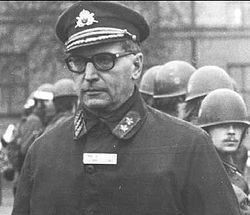Years of service 1944–1986 | Name Lennart Ljung | |
 | ||
Birth name Karl Hilmer Lennart Ljung Born 13 March 1921Solleftea, Sweden ( 1921-03-13 ) Commands held Chief of Army Staff (1972–74)Chief of Defence Staff (1976–78)Supreme Commander (1978–1986) Other work His Majesty the King's staff Died November 19, 1990, Stockholm, Sweden | ||
Lennart ljung on system identification toolbox advice for beginners
Karl Hilmer Lennart Ljung (13 March 1921 – 19 November 1990) was a Swedish Army general and Supreme Commander of the Swedish Armed Forces from 1978 to 1986. During Ljung's eight years as Supreme Commander many events of importance for Swedish security and defense policy occurred. Sweden had five different governments under four prime ministers from different political sides. Olof Palme was murdered, the submarine incidents culminated with the Soviet submarine U 137 running aground in Karlskrona and the decision of developing a new fighter aircraft came through.
Contents
- Lennart ljung on system identification toolbox advice for beginners
- Lennart ljung on the past present and future of system identification
- Career
- Time as Supreme Commander
- Other work
- Personal life
- Dates of rank
- Awards and decorations
- References

Lennart ljung on the past present and future of system identification
Career
Ljung was born in Sollefteå, Sweden, the son of captain Hilmer Ljung and his wife Greta (née Gustafsson). He passed his studentexamen in Gävle in 1941 and his officers exam in 1944. He became a second lieutenant in the Signal Corps in 1944 and attended the Royal School of Signals in 1950 and the Royal Swedish Army Staff College from 1952 to 1954. Ljung was promoted to captain in the Signal Corps in 1953 and attended the United States Army Command and General Staff College at Fort Leavenworth, Kansas from 1956 to 1957 when he became captain of the General Staff.
Ljung served at the Northern Scanian Infantry Regiment (I 6) from 1960 to 1961 when he became major of the General Staff. Ljung was teacher of strategy at the Royal Swedish Armed Forces Staff College from 1962 to 1963 and attended the Swedish National Defence College in 1963. He was promoted to lieutenant colonel in 1964 and served at the Gotland Regiment (P 18) from 1965 to 1966. He was promoted to colonel in 1966 and was head of the Operation Management 2 of the Defence Staff in 1966. He was after that commanding officer of the Uppland Signal Regiment (S 1) from 1968 to 1971, section chief of the Military Area Staff of the Eastern Military Area from 1971 to 1972 and was promoted to major general in 1972. The same year he became Chief of the Army Staff and acting military commander of the Western Military Area in 1974. Ljung was promoted to lieutenant general in 1976 and was Chief of the Defence Staff from 1976 to 1978.
Time as Supreme Commander
In 1978 he was promoted to general and appointed Supreme Commander. Ljung's time as Supreme Commander was marked by major transformations in the Swedish Armed Forces and by the constant financial pressure. It also consisted of renewal of the war planning, major military equipment projects, such as the Saab JAS 39 Gripen, a new kind of armed forces training and reorganization of both the leadership and the command organization. The handling of the submarine incidents and the systematic continuing submarine incursions also caused great strain on him.
Ljung was Supreme Commander during the submarine incident in Karlskrona when the Soviet submarine U 137 in October 1981 ran aground in Blekinge archipelago. By then he had a close collaboration with Prime Minister Thorbjörn Fälldin and was very prominent throughout the incident. His report on the whole situation excluded the possibility that the submarine accidentally ended up in Swedish territory, and he pursue in the coming years the issue of higher allocations to the military to fight the submarine intrusions which was considered coming from the Soviet Union.
According to Robert Dalsjö's doctoral thesis, Ljung was the last Supreme Commander who knew the secret peacetime cooperation with NATO, and also the one who discontinued the cooperation. In 1986, Ljung left the position of Supreme Commander and retired from military service and became chief of staff to His Majesty the King.
Other work
Ljung became a member of the Royal Swedish Academy of War Sciences in 1967 and honorary member of the Royal Swedish Society of Naval Sciences in 1980.
Personal life
In 1947, Ljung married Gertrud Öhman (1922–2005), the daughter of furrier August Öhman and Anna (née Nilsson). They had two children, Lars (born 1948), a retired colonel and senior adviser of the Folke Bernadotte Academy and Ann-Marie (born 1953). Lennart Ljung died in 1990 and was buried in Söderhamn cemetery.
